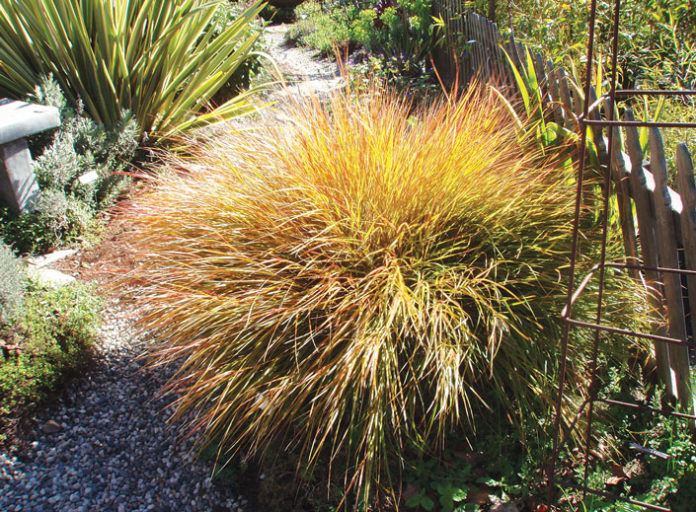What was I thinking trying to talk a client out of adding grasses to her former lawn area? I gave her all the reasons she should focus on other low water use, low maintenance, deer resistant plants, but I can’t get the vision of grasses back lit in the evening light and swaying gently in the breeze out of my mind so she’s going to get her wish. There are so many that do well in our area to choose from. Here are just a few that are my favorites.
There’s an ornamental grass for every type of garden. Whether you are striving to create the perfect perennial border or have a hot dry slope, grasses can work in harmony wherever you place them. There are some that are made for the shade, some that are perfect additions to a small water feature and many that are invaluable in container gardening.
Grasses are distinguished from other plant families by their growth habit. They grow upward from the base of a leaf or shoot and can regrow from the crown when cut back. There are other grasslike plants that resemble grasses in their growth habits and are often some of the best companions for interplanting with grasses. These include New Zealand flax, carex family sedges, libertia, chondropetalum, kangaroo paw, lomandra, dianella, cordyline and liriope to name just a few.
Are sections of your garden hot and dry? Grasses are survivors and are good choices for sunny spots that get little irrigation. Good drainage is a must for these plants so amend the soil with plenty of organic matter before planting. Combine drought tolerant grasses like Mendocino Reed Grass (pennisetum foliosa) with companion plants and a few accent rocks to complete your dry theme. If you like blue foliage, try Elijah Blue fescue grass with Amazing Red flax for a show stopping combination.
If you are trying to create a focal point or destination in your garden and think the texture, light and movement of a grass would be perfect, look to the taller varieties. A personal favorite is Stipa gigantea or Giant Feather Grass. They take drought conditions once established but also will grow with regular garden watering. The beautiful flower spikes are good in dried arrangements. Giant Feather grass looks great with the purple flowers of penstemon “Midnight.”
There’s a reason old favorites like Karl Foerster Feather Reed Grass are so popular in landscapes. It doesn’t get too tall or overpowering in the smaller garden and its upright habit is neat and tidy. Outside my front door are several Overdam Feather Reed Grasses that are spectacular when backlit by late afternoon sun. What’s not to love about a stunning variegated grass with white and green stripes? Now in the summer, pink flower plumes sway above the foliage. In the fall, the buff-colored flower spikes will remain until I cut everything back to 6 inches just before new growth starts in winter.
Pheasant Tail grass is another popular grass that is carefree and long-lived. It grows to only 3 by 3 feet, is not fussy about soil and looks good anywhere you plant it. It combines beautifully with the sky blue flowers of Russian sage and is extremely drought tolerant once established.
Caring for grasses is easy. As a rule of thumb, if it browns in winter then cut it back before new growth starts. If it’s evergreen by nature, just clean up the outside leaves. Most like well drained soil and are tolerant of a wide range of garden conditions. You shouldn’t fertilize heavily because an excess of nitrogen can lead to lush, soft growth that tends to flop. Mulching with 2 inches of compost yearly will keep the soil and your plants in good shape. Water grasses regularly during their first year to help get a good root system established. Even grasses that are normally touted as drought-tolerant require a season or two to become fully established.
These are just a few of the places where grasses can enhance and add beauty to your garden.
Jan Nelson, a landscape designer and California-certified nursery professional, will answer questions about gardening in the Santa Cruz Mountains. Email her at ja******@*ol.com, or visit jannelsonlandscapedesign.com.













